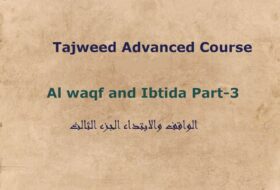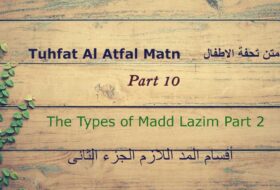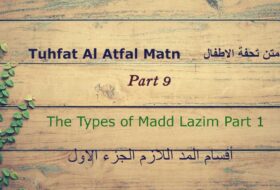Tajweed Course for beginner Part-19
THE MUDOOD (LENGTHENINGS) PART 5 احكام المدود الجزء الخامس
lengthening caused by a Sukoon :
2-The Lengthening with a Presented Sukoon : المــد العارض للسكون
This occurs when there is a sukoon placed on a letter by the reader due to stopping in the recitation (whether in the middle or end of an ayah).
Requirement :
- Requirement : Natural madd letter
- Followed by a sukoon (as the reader has chosen to stop on it)
Note :
1-Although this will not be actually visible in the Qur’an, but is implied as the reader has chosen to stop on it.
2-This Madd only exists if the reader stops on that word. If the reader does not stop on it, it should be considered as a Madd Tabee’ee (2 beats).
Effect :
- Elongate 2, 4 or 6 counts
- Preferred 4 or 6
⇒ Free Helping in Quran And Tajweed ⇐
Examples:

3The Soft Lengthening المــد اللين
Leen means “easy”.
The Leen letters:- A Waaoo ( و (or Yaa’ ( ى (Saakin preceded by a letter with a Fathah.
When should we do this Madd?
If one of the Leen letters is followed by a letter at the end of a word, which has been Saakin due to stop (8), the reader should prolong the Leen letter. The reader can choose to prolong it 2,4 or 6 beats .
Note:
Although this will not be actually visible in the Qur’an, but is implied as the reader has chosen to stop on it.
Requirement :
- Madd letter
- Followed by a sukoon (and the reader has chosen to stop on it).
Effect :
- Elongate 2, 4 or 6 counts
- Preferred is 4
Examples:

Madd Sila مد صلة
This occurs when the possessive pronoun (shown as when attached to the previous letter), which denotes the 3rd person singular masculine, falls between 2 letters that carry a vowel.
Two types: Major كبرى and Minor صغرى
1-Major كبرى
Requirement :
- The possessive pronoun
- Followed by hamzah ( ء ) mutaharrik
Effect :
- Elongate 2, 4 or 5 counts
- Preferred 4 or 5
Further Notes :
- Preferred elongation is 4 or 5 to illustrate that it is not the natural madd of just 2 counts .
- Those who have no or little knowledge of the Arabic language may not understand the usage of the possessive pronoun which basically refers to the third person singular masculine. A tiny / will be present to indicate this rule .
Examples:

2-Minor صغرى
Requirement :
- The possessive pronoun .
- Followed by any letter other than hamzah ( ء ).
Effect :
Elongate 2 counts only .
Examples:

EXCEPTIONS TO THE RULE OF MADD SILA:
There are 4 instances in the Qur’an where the rules of MADD SILA will not apply.
1. Surah Al Furqan (25:69) Hafs lengthens it even though the letter preceding the ‘ha’ is saakin, and not mutaharrik.
{وَيَخْلُدْ فِيهِ مُهَان}
2. Surah Zumar (39:7) The ‘ha’ is not elongated, even though it is between 2 letters that are mutaharrik .
( وَإِنْ تَشْكُرُوا يَرْضَهُ لَكُمْ )
3-Surah Naml (27:28) Hafs reads it with a sukoon ( ) on the ‘ha’. As it carries a , it would probably be read this way anyway .
{فَأَلْقِهْ إِلَيْهِم}
4. Surah Ash-Shura (26:36) Hafs reads it with a sukoon ( ) on the ‘ha’. As it carries a , it would probably be read this way anyway .
{قَالُوا أَرْجِهْ وَأَخَاهُ}
learn-pillars-of-islam
islamic-studies
al-idgham-as-saghir
mistakes-in-tajweed-rules














